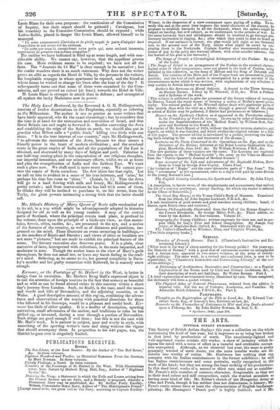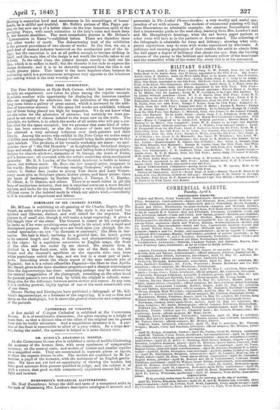THE ARTS.
SUFFOLK STREET EXHIBITION.
THE Society of British Artists displays this year a collection on the whole maintaining the level of last year, but it impresses us as being less broken in that level by productions of merit. The excellently-lighted and well-appointed rooms contain 639 works; a show of industry which fa- tigues the mind with a sense of effort in a tasteful and creditable occupa- tion unrequited. Although, as we observed last year, the mass is pretty generally weeded of mere daubs, yet the more notable works are de- cidedly less worthy of notice. Mr. Hurlstone has nothing that can compare with his Italian reminiscences in the former exhibition: he still has Italian reminiscences and some portraits, easily recognized as the work of his hand; but they are among the least striking of his productions. In this dead level, works of a second or third rate stand out as notables: Mr. Prentis's able snatches of common character, disagreeable as they are in their dead colour and stiff composition, catch the wearied attention as having some kind of life; Mr. Zeitter's sketch of the Hungarian Army at Oren and Pesth, though it has neither date nor distinctness, is history; Mr. Pyne's rustic scenes have at least the characteristics of English landscape- painting; Mr. Montague's "Dutch port" is highly finished; and if Mr. Herring is somewhat hard and monotonous in his assemblages of horses' heads, he is skilful and truthfuL Mr. Noble's picture of Mrs. Pepys put- ting on her new sae is of a better class-in the true luxurious spirit of the gossiping Pepys, with much animation in the lady's mien and much force in her buxom shoulders. The most remarkable picture is Mr. Dobson's "Lamentation in Rama"-exhibited before. There are therefore these and other works of merit. The disheartening trait of the exhibition is the general prevalence of two classes of works. In the first, we see a good deal of trained industry bestowed on the mechanical part of the de- sign; but the execution is not at all perfect enough to become striking in itself; and the main idea of the design is not worth the trouble taken to set it forth. In the other class, the painter intends merely to dash out his idea, which is to suffice in itself; but the dbaucbe is too rude to express the design distinctly, and it is to be shrewdly suspected that the idea is not worth greater pains. This latter is the more hopeless class, because its animating spirit is a presumptuous arrogance very opposite to the laborious painstaking which is the true worship of art.



























 Previous page
Previous page